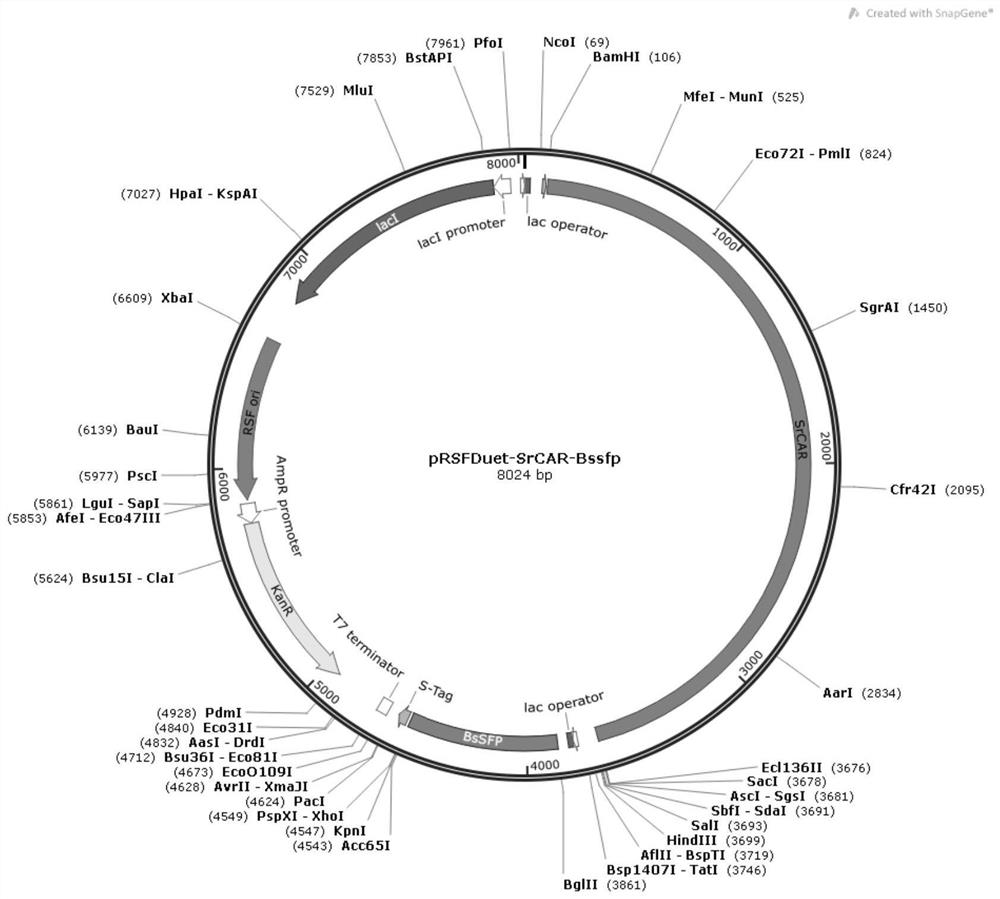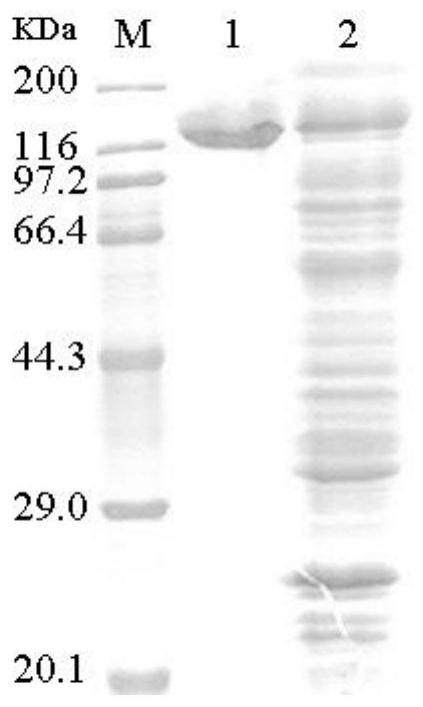Carboxylic acid reductase recombinant plasmid as well as construction method and application thereof
A technology of recombinant plasmid and reductase, applied in the fields of genetic engineering and microorganisms
- Summary
- Abstract
- Description
- Claims
- Application Information
AI Technical Summary
Problems solved by technology
Method used
Image
Examples
Embodiment 1
[0025] Example 1: Construction of recombinant bacteria containing carboxylic acid reductase SrCAR gene sequence.
[0026] Synthesize the fragment of the gene (shown in SEQ NO.3 in the sequence listing) encoding carboxylic acid reductase SrCAR in the present invention by chemical synthesis, and combine it with the phosphopantetheinyl group derived from Bacillus subtilis (Bacillus subtilis) The transferase gene fragment (shown in SEQ NO.4) was connected to the pRSFDuet-1 vector, transformed into Escherichia coli competent cells, the positive cloned plasmid was extracted and analyzed by restriction enzyme map, and the recombinant plasmid pRSFDuet-SrCAR carrying the SrCAR gene was verified to be obtained -Bssfp, recombinant expression vector pRSFDuet-SrCAR-Bssfp as shown in the figure figure 1 shown. The thiolation domain of carboxylic acid reductase requires post-transcriptional modification, which covalently attaches the phosphopantetheinyl group to the conserved serine catalyz...
Embodiment 2
[0030] The correct clone identified in Example 1 was cultured overnight, then transferred to LB medium containing 1 μg / mL kanamycin for cultivation, until the bacterial solution OD 600When the concentration is 0.6-0.8, add IPTG with a final concentration of 1.5mM to induce expression at 30°C. After induction for 8 hours, collect the bacterial liquid, 8000rpm, 5min, discard the supernatant medium, wash twice with PBS equal volume, add Appropriate amount of PBS to make the resuspended bacteria OD 600 =40, add 15% (v / v) glycerin, 1mM phenylmethylsulfonyl fluoride (PMSF), and mix on a vortex machine; break with an ultrasonic breaker, ultrasonic break conditions: the working time is set to 20min, every Work for 5 seconds, rest for 4 seconds, set the power to 25%, and obtain crude enzyme solution of carboxylic acid reductase after crushing. The obtained carboxylic acid reductase crude enzyme solution was filtered with a 0.22 μm membrane to remove impurities, and 2 mL of the crude e...
Embodiment 3
[0031] Example 3: Research on enzymatic properties of carboxylic acid reductase SrCAR.
[0032] The pure enzyme solution obtained in Example 2 was subjected to research on enzymatic properties, including enzyme activity, specific activity, optimum temperature and optimum pH, etc. Enzyme activity was measured by UV spectrophotometer.
[0033] Carboxylate reductase enzyme activity assay uses 1mL reaction system, which contains 400mM Tris-HCl (pH=7.5), 5mM D-lactic acid, 10mM MgCl 2 , 150mM NaCl, 1mM ATP, 0.15mM NADPH, 1mM DTT and 20μL of enzyme, set the wavelength at 340nm, measured once every 2s, measured for 3min, blank control without enzyme. One activity unit is defined as the amount of enzyme used to oxidize 1 μmol of NADPH per minute as one enzyme activity unit. The specific enzyme activity was calculated according to the following formula:
[0034]
[0035] Where: V T is the total reaction volume, ml; V S is the sample volume, ml; ΔA is the change value of absorba...
PUM
 Login to View More
Login to View More Abstract
Description
Claims
Application Information
 Login to View More
Login to View More - R&D
- Intellectual Property
- Life Sciences
- Materials
- Tech Scout
- Unparalleled Data Quality
- Higher Quality Content
- 60% Fewer Hallucinations
Browse by: Latest US Patents, China's latest patents, Technical Efficacy Thesaurus, Application Domain, Technology Topic, Popular Technical Reports.
© 2025 PatSnap. All rights reserved.Legal|Privacy policy|Modern Slavery Act Transparency Statement|Sitemap|About US| Contact US: help@patsnap.com



